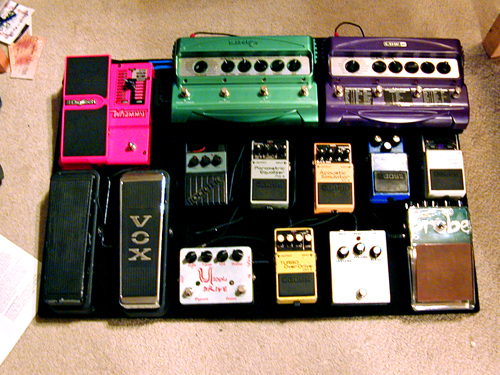The previous generation of acoustic simulation pedals earned a reputation for sounding flat and tinny, but more recent models have made great strides toward authentic sound reproduction and are certainly worth considering when you’re adding sound options to your pedal rack. Below, you’ll find our reviews of the 4 best acoustic simulator pedals on the market.
Boss AC-3
The AC-3 pedal uses Boss’ COSM acoustic modeling technology which gives more precision to the sound simulation, giving you the closest thing you can get to an acoustic sound without lugging an extra instrument to your gig. The AC-3 offers four modes of simulation (standard, jumbo, enhanced, and piezo) while body, top, and reverb adjustments give you even greater control over your tone. Multiple outs give you the option of using the pedal as a bypass of your other effects when you’re simulating an acoustic tone, making it perfect for quick switches during a show.
Mooer Acoustikar
Mooer is on the leading edge of the micro pedal market—or in other words, effects pedals that sound good but don’t take up so much space on your rack. The Acoustikar has three different modes of acoustic sound recreation. Use the standard mode for the typical acoustic guitar sound, or get a variation on your tone with the jumbo mode and the piezo mode, then use the level and body controls to tweak your sound and dial it in to the perfect acoustic simulation for your set-up. The Acoustikar has a true-to-life acoustic sound reproduction in a compact package at an affordable price that makes it perfect for the gigging guitarist. It’s one of the best acoustic simulator pedals period.
Joyo Ironman Wooden Sound Acoustic Simulator
The greatest strength of the Joyo Ironman shows on strumming lines. Unlike past models of acoustic simulators, this pedal gets an open and resonant tone that’s not too thin or heavy on the treble. The flippable cover on the casing is a nice touch, keeping your settings from being changed accidentally in the hectic on-stage environment. Though it only has a single mode of acoustic simulation, the Joyo gives more in-depth EQ controls than other models on the list, and it’s also more compact than many other acoustic simulators, making it a convenient alternative to bringing an acoustic guitar to your shows. This should be on anyone’s list of the best acoustic simulator pedals.
Koogo Guitar Acoustic Pedal Analog Acoustic Guitar Simulator Pedal
Here’s another option that’s surprisingly affordable given the array of options it gives you. The Koogo Guitar Acoustic Guitar Simulator Pedal has a sturdy, all-metal construction in a compact pedal that won’t take up too much space on your rack. It has 3 modes: Piezo, Standard, and Jumbo.
Within each mode, you can adjust the Top, Volume, and Body—a nice level of control that lets you get your perfect acoustic tone. The overall sound is mellow and natural, and it has a true bypass for when you don’t want to use the effect. While it’s designed for guitar, this pedal also sounds fantastic used with other instruments, like synthesizer or electric violin.
Simulation Modes
Many acoustic simulator pedals will come with a variety of modes you can use to get different styles of acoustic sound out of your instrument. These modes can often be further tweaked by using the EQ and other adjustment knobs on the pedal, but by switching modes you’ll get a completely different sound profile and coloration on your tone.
There are two simulation modes that emulate different body types of acoustic guitars. The standard mode on an acoustic simulator emulates the sound of your typical acoustic guitar. If the pedal doesn’t specify what kind of simulation it provides, it’s probably a standard. The next most common simulation mode is called “jumbo,” and is a simulation of a Super Jumbo or Jumbo guitar, similar to the Gibson SJ-200 model that’s been around since the 1930s. A jumbo acoustic has a deeper bass and broader sound, thanks to its large body, and is most popular with rhythm players.
Beyond emulations of different body styles, you’ll also often find a “piezo” mode on acoustic simulators. Short for “piezoelectric,” piezo refers to a distinctive style of pickup which uses pressure instead of magnets to engage an electrical charge. Piezo pickups give an acoustic guitar a more pure, clean sound with a brighter edge that’s great for cutting through an ensemble.
Different modes of simulation give you more options for adding color to your tone, but may not be necessary for your particular playing style. If you only want to use standard acoustic simulation, it may serve you better to get a single-mode model like the Joyo Ironman above; leaving out the mode feature makes for a simpler and more compact unit.
Other Considerations when Selecting the Best Acoustic Simulator Pedal
Even single-effects pedals like acoustic simulators can have a lot of variations between different models. Beyond looking for a high-quality and durable pedal, you want to find the one that’s got the features to suit your needs. The COSM modeling technology at work in the Boss AC-3 (see full specs) has the potential for the most realistic acoustic simulation, and will be a benefit to you if you plan on switching quickly between electric and acoustic tones, but will not work correctly if you don’t utilize both outputs. If you prefer the option of a simpler single-out set-up, the Mooer or the Joyo (see full specs) will be more your style.
Consider, too, the tonal variation control the different pedals give you. The full range of EQ available on the Joyo allows a lot of fine tuning but you may not find it necessary if you prefer to do EQ adjustments at the amp level. Features like the reverb control on the Boss AC-3 might be similarly unnecessary if you prefer to add reverb with a designated pedal. Tailoring your new equipment to your instrument and ideal sound is a great way to make sure you’re happy with your new purchase and that it’s giving you the acoustic simulation that you’re looking for.









Thank you for this post. It was very usefull for me. Congrats from Brazil!
Good article. And thanks for including the videos. A friend asked me to recommend an acoustic simulator (something iut of my wheel house) and I was fortunate enough to find your article. Thanks!